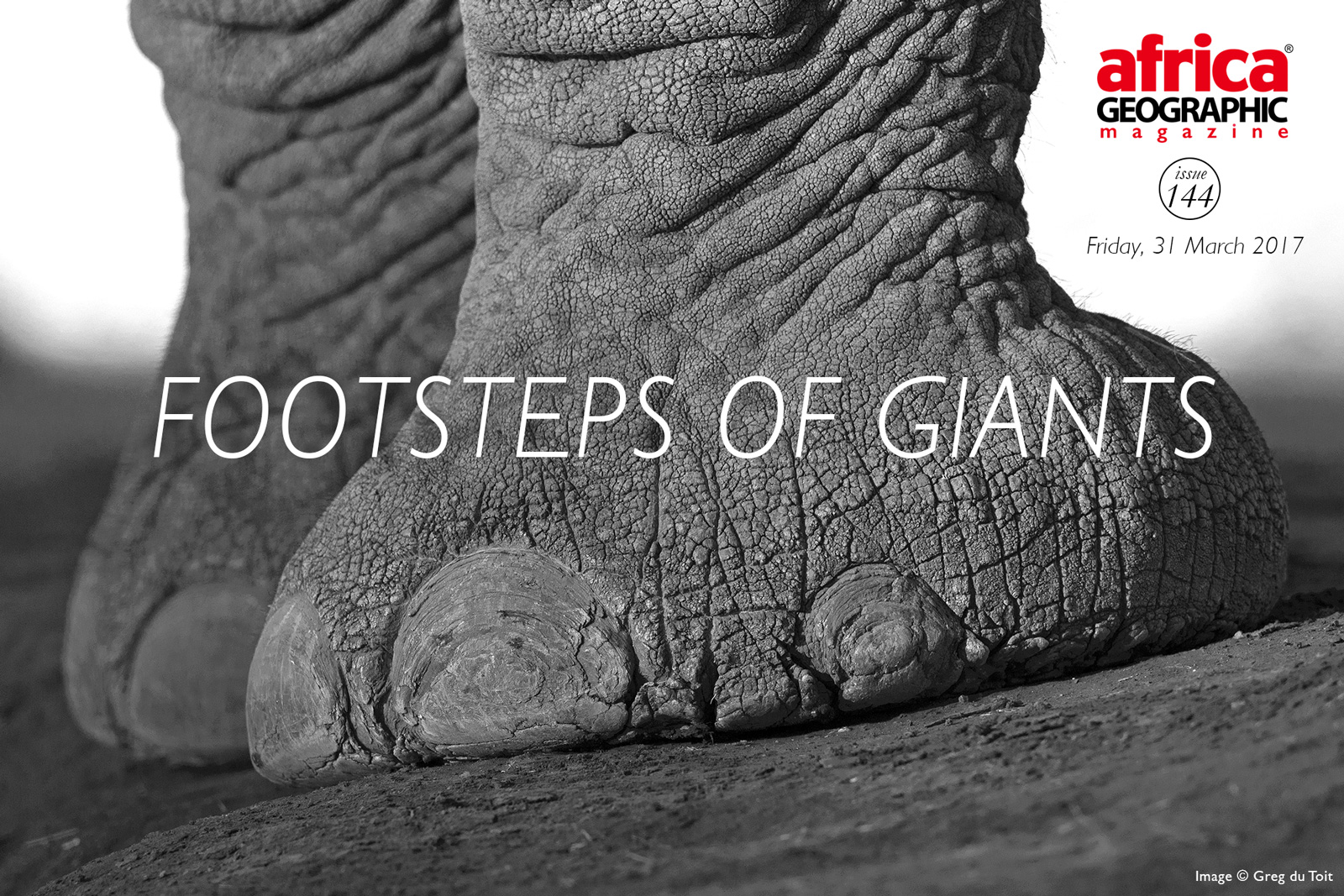
In the Footsteps of Giants

Professional wildlife photographer Greg du Toit has photographed some of Africa’s wildest, remotest and largest ecosystems. His artwork has hung in both the London and Sydney natural history museums and his ‘Authentic Africa’ collections have been exhibited across the globe, from New York to Singapore. African wildlife is his speciality, and his preferred genre is fine-art wildlife photography, whereby his photographic works are easily recognised by the tangible mood, primitive energy and vibrant colours that they convey.
In this body of work, entitled ‘In the Footsteps of Giants‘, Greg spent three years photographing elephants around Africa in unique settings and locations – mainly from inside waterholes! Read the photographer’s note on this portfolio below:
“I hope that through this body of work people will appreciate what incredibly wonderful creatures elephants are. Sadly, Africa has lost 70% of its elephant population in the last 40 years and alarmingly, in these modern times, elephants are being hunted and poached at a faster rate than they are being born. Hunters come out to shoot elephants so that they can take trophies home to brag. Poachers kill elephants just so that their teeth can be turned into ornaments. I hope that this body of work will help create greater love and appreciation for elephants and awaken the collective human conscience so that these wonderfully intelligent and gentle giants will be around for future generations to see and enjoy. Climbing into the water to photograph them would be a minimal price to pay if this were to happen.”
See more of Greg’s work on his website and follow him on Instagram

The image that won Greg the coveted ‘Wildlife Photographer of the Year’ award in 2013 © Greg du Toit
The Essence of Elephants
This is a significant photograph, on a personal level, I mean. Yes, it won me the highest accolade in world wildlife photography back in 2013, but more than this, it sparked me on a three-year journey that has been simply incredible.
When I took this shot, I thought it was the end of my journey with elephants as it came after many years of trying to capture the mysterious quality of elephants in a photograph. But, as it turns out, it was only the beginning. Since taking this shot, I have spent the last three years working on my ‘In The Footsteps Of Giants’ project whereby I have spent hundreds of hours with elephants. I have flown in helicopters looking for giant tuskers, and I have descended into an extinct volcano (Ngorongoro) to do the same. I have been to the Congo basin and the Skeleton Coast in search of elephants. I have even sat inside a waterhole with them. It has been a spellbinding journey, and now I have this body of work that I can proudly share with the world.

A herd of elephants crosses the plains of Amboseli National Park, Kenya © Greg du Toit
The Elephants of Mount Kilimanjaro
The snowcapped peak and glaciers of Mount Kilimanjaro feed the swamps at her base, and one of my goals for my ‘In The Footsteps Of Giants’ project was to capture an elephant herd making its evening sojourn across Africa’s dry plains.
Here, you see a herd in the twilight, crossing the dry lakebed of Amboseli National Park, with the base of Mount Kilimanjaro in the background. Having quenched their thirst, they are heading back to their feeding grounds for the night. The parade of elephants disturbed insects in the grass, much to the delight of the accompanying egrets. Everything in nature is connected.
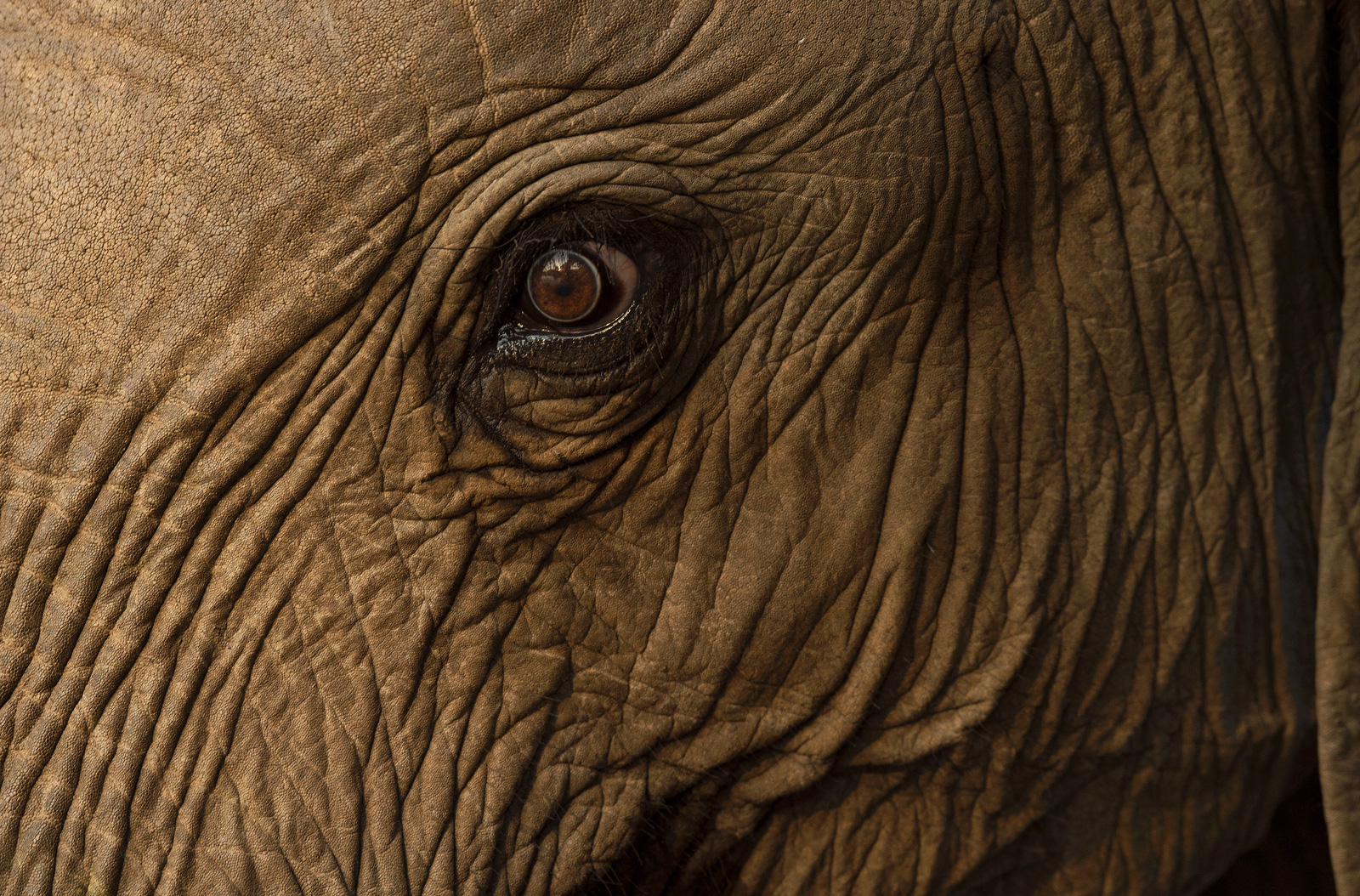
Connecting with the soul of the elephant is something that Greg strives to achieve in his work © Greg du Toit
Looking into the soul
Elephants fit into that special category of animals with tangible souls. They are undoubtedly intelligent; but are far more than that. When you spend time with them, you eventually come to recognise something of yourself in them, and for this reason, it was essential for this project that I capture the eye, or rather the soul, of an elephant. I took hundreds upon hundreds of photographs of elephants’ eyes, but this shot rose to the top for me. This is the frame that connects me with this magnificent beast, and I hope it does the same for you.

Two young bull elephants fighting © Greg du Toit
Young bulls
Young elephant bulls often wrestle with one another. This behaviour, while fun, is also critical as it prepares the young males for the more serious fights that they will one day face when they have to ward off rival bulls for mating rights.
The beauty of a photograph lies in its ability to capture a single moment in time. In a fraction of a second, the camera affords us the gift of suspending a singular point in both time and space. For this image, I tried to delay the recording of this moment, and I managed to delay it just long enough for the energy of the young bulls fighting to transfer into my camera. Any longer and the moment would have dissolved.
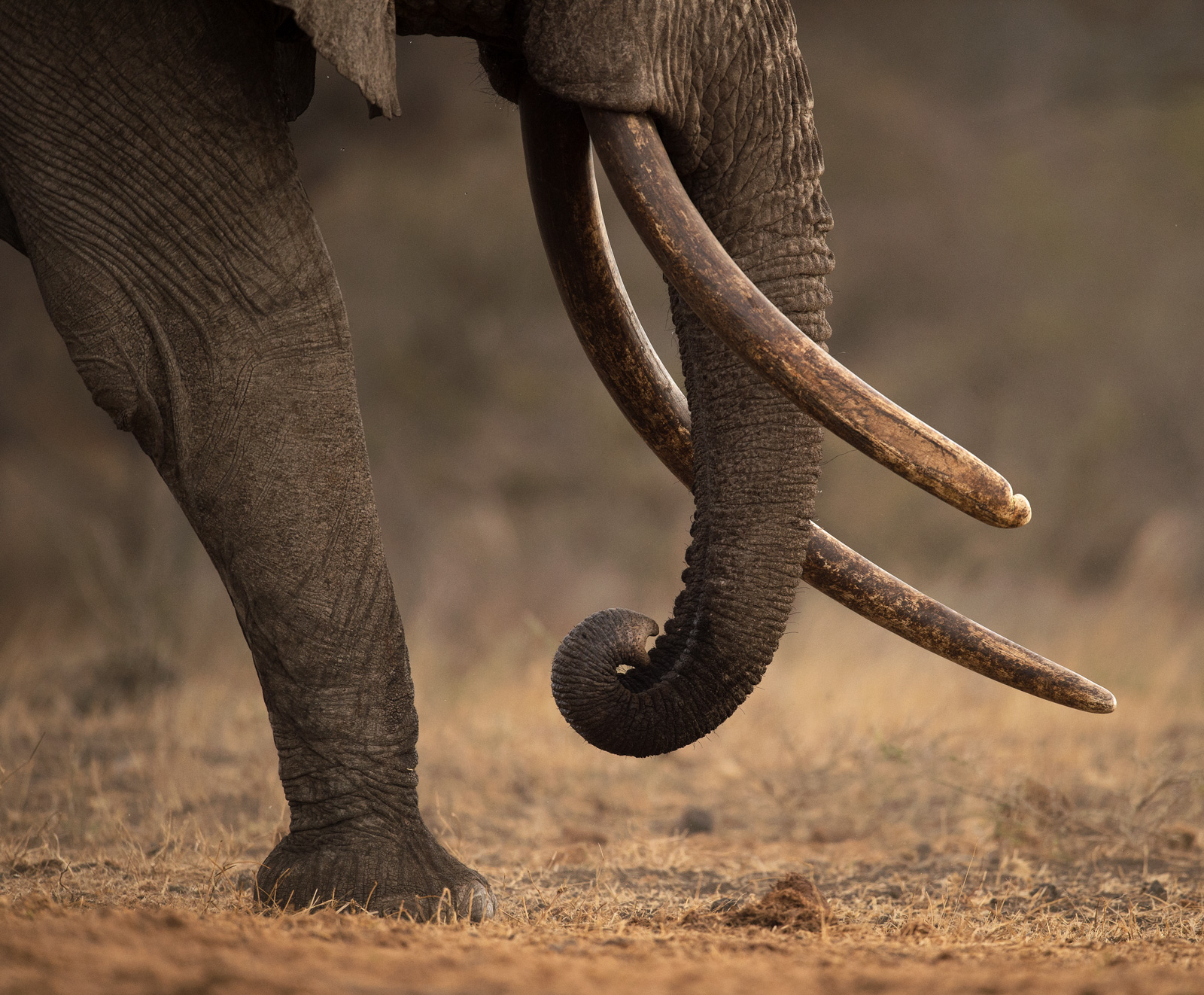
It is a privilege to see a Big Tusker elephant in the wild today © Greg du Toit
Big Tuskers
Seeing a Big Tusker is now an infrequent occurrence because their gene pool has been thinned out, by both hunters and poachers. But, they do still exist, and we must make sure that they always do! For to see such an animal is like seeing a dinosaur; it is a living version of the ancient mammoth and a most mythical beast. It was in Kenya that I, late one evening, came across this incredible tusker and not knowing quite how to photograph him, I chose to exclude his head and body. I wanted to draw attention to his large tusks, but more than that, I wanted to preserve the mystery of this mythical beast and to present my subject as a prehistoric giant stepping into the frame.
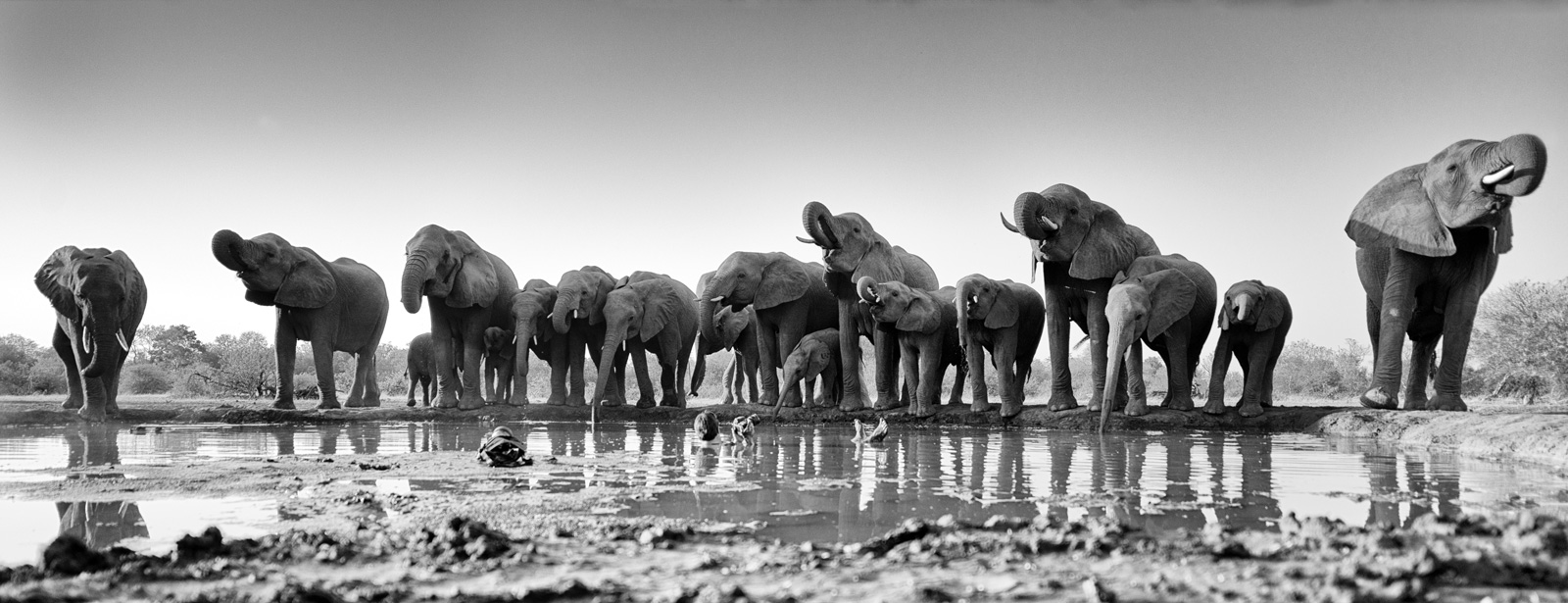
Getting in under the noses of elephants, as Greg does © Greg du Toit
Taking it all in
It was late November and the end of a drought in Botswana’s Tuli Block. On this particular afternoon in the waterhole, there had been nonstop action, and although I was in the water, I was sweating. This was partly due to the heat and partly because the largest land mammals on planet earth surrounded me! Their toenails looked huge as they towered above me!
It might be hard to appreciate looking at this photo, but the waterhole is the size of a small domestic swimming pool, so I was right under their noses – or should I say trunks? The life of a wildlife photographer can, at times, be very boring – and at other times, extremely exciting, to the point where you are flirting with the thin line that separates life and death. Thankfully, I have enough experience now to slow down and appreciate those special moments when I am right on the line. Here you see me dropping my camera and taking it all in, just for a moment.
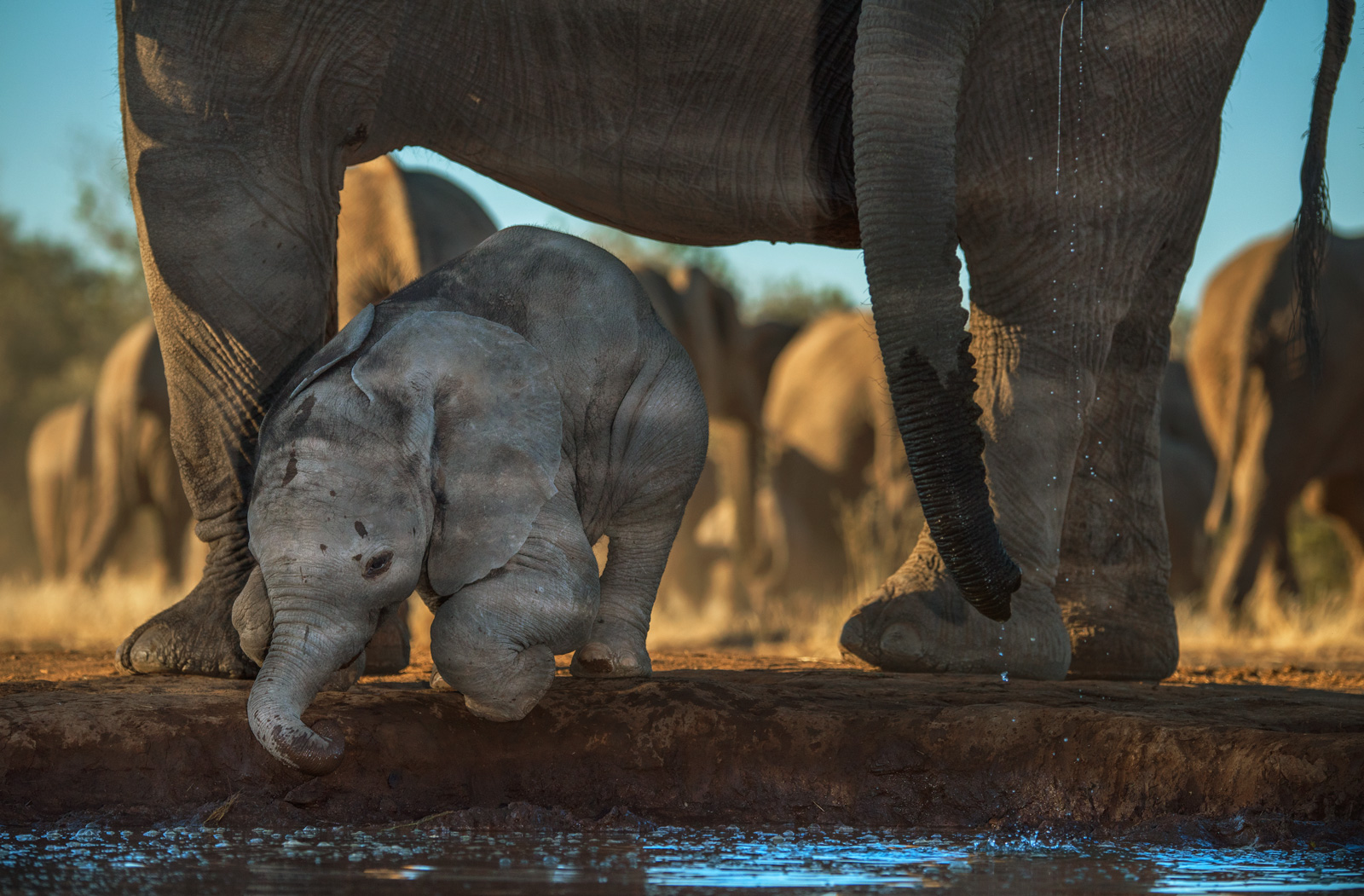
A baby elephant tentatively learning how to drink © Greg du Toit
Life’s lessons
One of the significant advantages of photographing at the waterhole was that the elephants, although they knew I was there, never saw me as a threat. Elephants are wonderful mothers and very protective of their herd, but the elephants in the Tuli Block of Botswana know that it is a safe haven for them, and the mothers are more relaxed than in other parts of Africa.
Being a professional wildlife photographer, I am often afforded a window into the world of wild animals – and this is a great delight and privilege, but never more so than when a baby elephant goes about its business of learning life’s lessons. Here you see this young elephant trying to get to grips with her trunk and how exactly she should go about having a drink. Her mother stands patiently above her.

A little calf elephant getting excited as it heads for a drink at a waterhole © Greg du Toit
Leading the charge
One of the most amazing things to witness in the African bush is an elephant herd getting excited about a visit to the waterhole. Although elephants can’t officially run (they can only speed walk), it must be said that they come closest to running when approaching a waterhole.
The herd gets visibly excited as they rush towards the water, and here you see a little calf leading the charge.

A baby elephant playing in the mud © Greg du Toit
Bath time
With a baby elephant only two metres away, and at eye level, it splashed mud everywhere. As I focused on its eye, my camera got covered in mud. Just another day at the office for me! And a reminder to have fun and play!
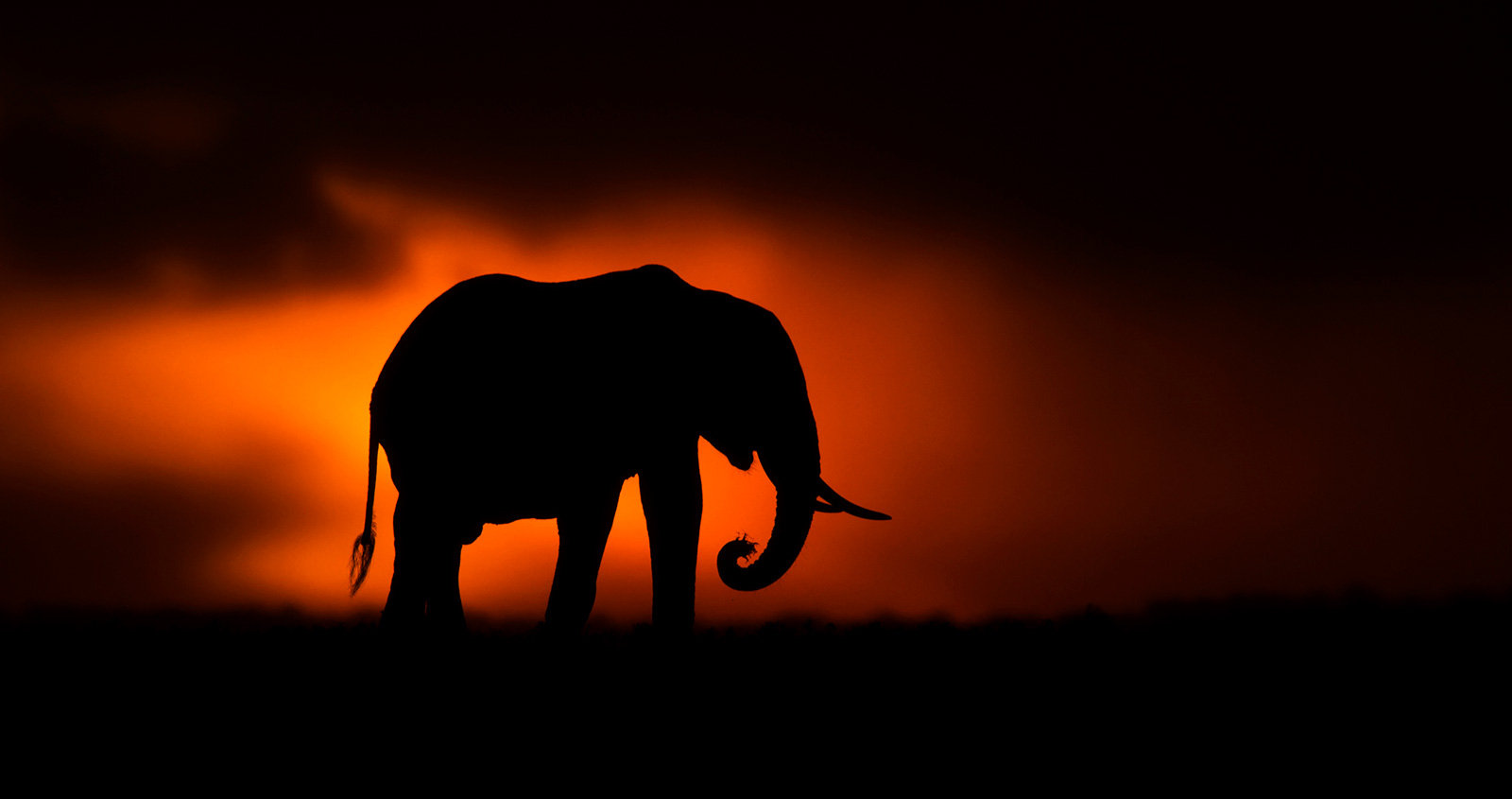
A special pachyderm in the last light at Maasai Mara National Reserve, Kenya © Greg du Toit
Golden sunset
Occasionally one is treated to a special sunset, the kind that glows long after the sun has disappeared below the horizon. It was when leading a predator safari in the Maasai Mara that my guests and I witnessed one such sunset, and by positioning ourselves in a valley, we had a magnificent and silhouetted subject in the form of an elephant. The pachyderm was slowly walking along the ridge, plucking grass – and in the very last light of the day, I managed to squeeze out one more frame. This is that special frame.

Locking eyes with a gentle giant © Greg du Toit
Beauty and mystery
This big boy had swum out into the middle of the Zambezi River, where he was enjoying the cool water and the lush green grass on an island. It was late November and the hottest time of year in the Zambezi Valley. I longed to jump in with the bull and celebrate life just the way he was. I even asked my guide if I could, but he was quick to point out the danger of crocodiles!
He was right, of course.
All I could do was lie down on the boat and watch with fascination as the largest land mammal on earth frolicked in the water. The sun eventually set, and the watery foreground turned into an orange swirl. Light rays refracted, reflected and bounced onto the face of my subject. Our eyes locked, and I immediately recognised that I could potentially capture a photograph that conveyed the beauty and mystery of one of God’s greatest creatures. Moments like this are what make me feel so incredibly privileged to do what I do, and I am so grateful that the camera allows me to share them with you.
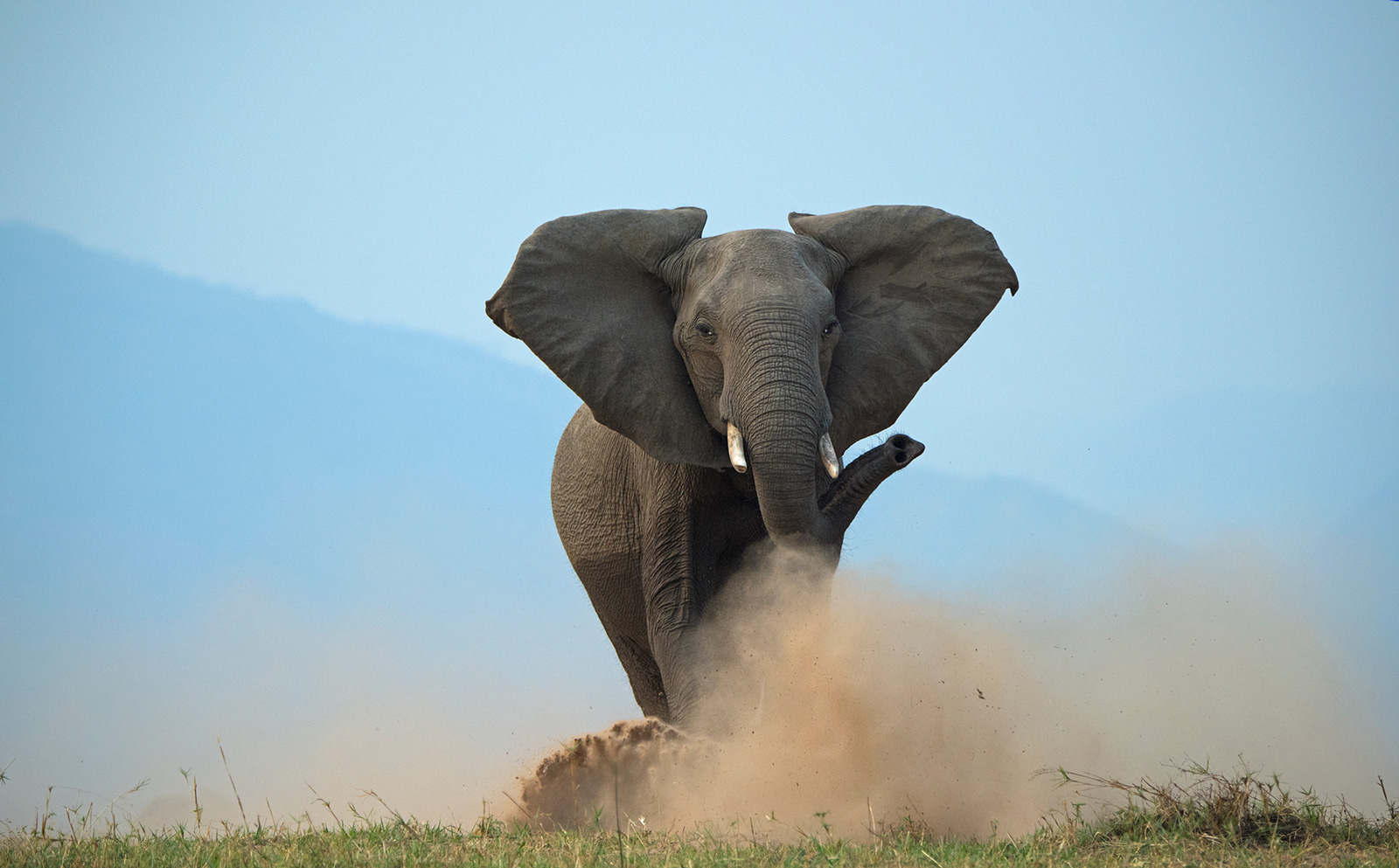
An elephant charges out of nowhere on the Zambezi River © Greg du Toit
Kicking up a storm
My wife and I were canoeing on the Zambezi River when out of the blue, this elephant came charging at us from beyond the riverbank. There was nowhere to hide, and so I dropped my oar and picked up my camera (much to the dismay of my poor wife, I might add). More often than not, when an elephant comes rushing at you kicking up a storm, they are ‘mock charging’ and have no intention of harming you, rather just giving you a friendly warning sign to move away.
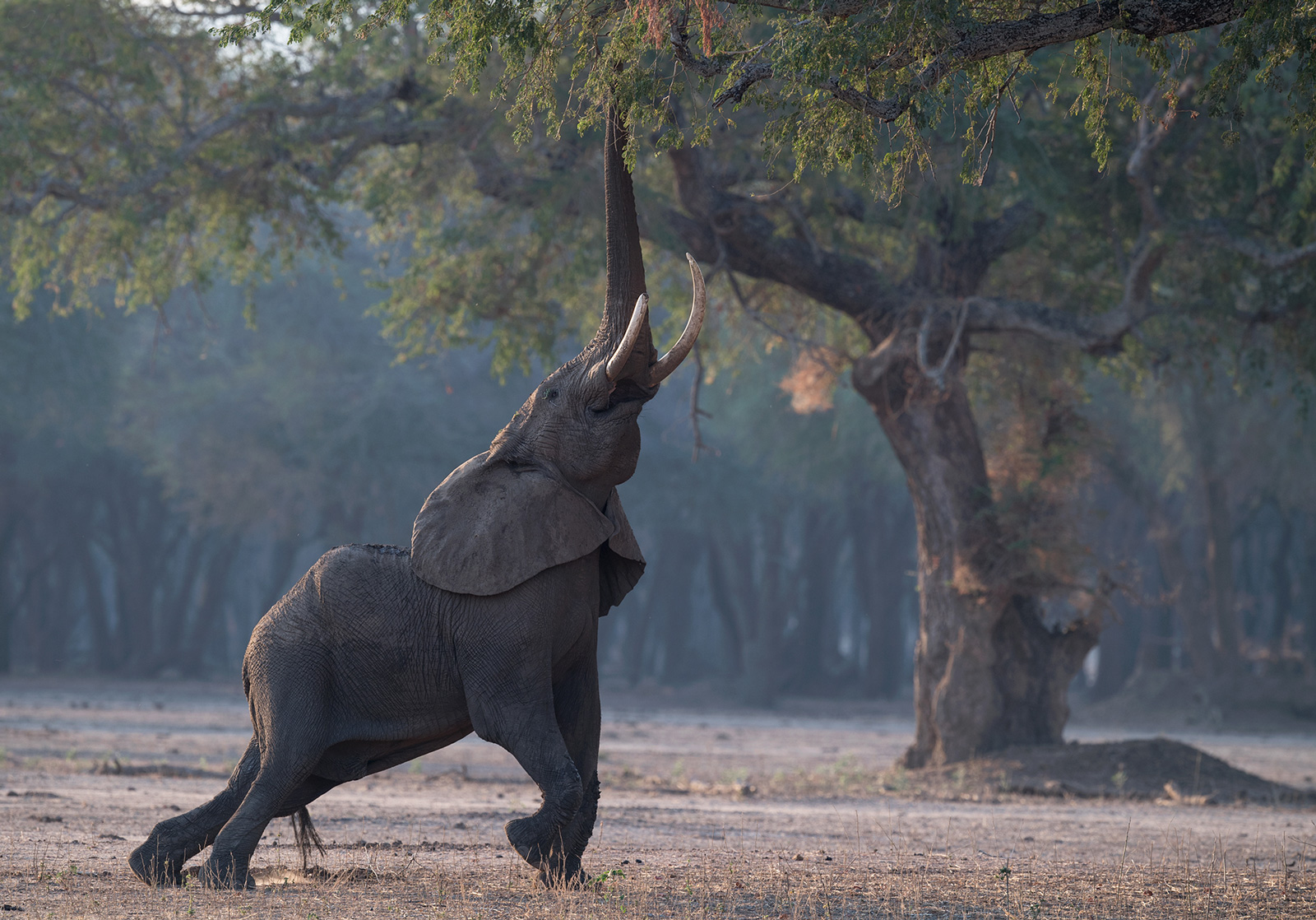
A magical scene in the Zambezi Valley © Greg du Toit
Leaning in
In a remote forest clearing in the Zambezi Valley, I spent the afternoon with this elephant bull. He was most interested in the pods of the Winterthorn tree and in an attempt to reach them, he leaned in and stretched his trunk as high as he could. The soft afternoon light was filtering through the forest, creating orange and blue hues. It was a magical scene.
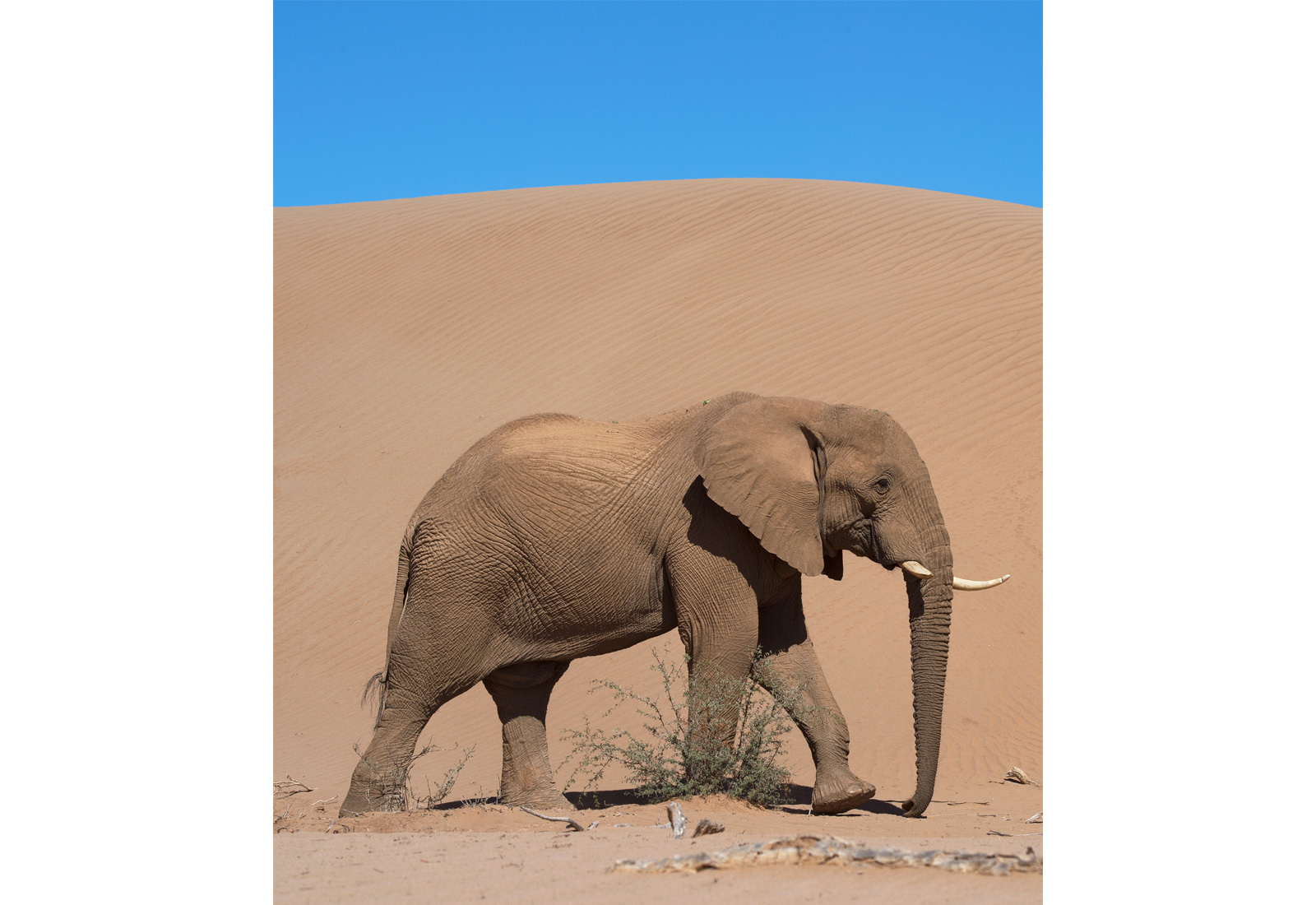
A mysterious desert-adapted elephant on the Skeleton Coast of Namibia © Greg du Toit
Desert-adapted elephants
It had long been a dream of mine to see and photograph a Namibian desert-adapted elephant. It remains an incredible mystery to me how these gigantic creatures can survive in a harsh desert.
I was more than chuffed to finally catch up with this bull on the Skelton Coast of Namibia.
Following the bull, as he passed by a sand dune, I knew that this would be the frame that I had come here for. I had to travel all the way to the Congo to get a shot of a forest elephant and juxtaposed against this frame, I can only marvel at the adaptability of this incredible species. I believe that we will win the fight to halt elephant poaching and that they will roam deserts, forests and savannahs for future generations to see and enjoy. I must believe this, I am a wildlife photographer and an ambassador for wild creatures. It is my duty to bring inspiring portraits of elephants to the world. It was, after all, Sir David Attenborough, who once said that “images have the power to affect how we feel about the natural world and therefore how we treat it.”

Greg at work inside the waterhole for his project, ‘In the Footsteps of Giants’ © Greg du Toit
Kicking back
At work inside the waterhole for my ‘In The Footsteps Of Giants‘ project. I hope that this body of work will be remembered, not because of the crazy photographer who climbed into a waterhole, but rather for the awareness it raised and for drawing attention to elephants. All animals are special and consequential and need to be conserved, but elephants seem to me to be extra special animals. They possess a rare kind of intelligence and cognitive understanding. They are giant, yet gentle creatures and they are also a keystone species to the ecosystem, meaning that should they go extinct, the entire ecosystem will fail. We need to continue working hard to ensure that doesn’t happen.
For camps & lodges at the best prices and our famous ready-made safari packages, log into our app. If you do not yet have our app see the instructions below this story.
To comment on this story: Login (or sign up) to our app here - it's a troll-free safe place 🙂.![]()






